Melioidosis in Sri Lanka
Abstract
1. Introduction and History of Melioidosis in the Country
2. Review of Melioidosis Cases and Presence of B. pseudomallei in the Country
3. Current Recommendations and Availability of Measures Against Melioidosis
4. Awareness of Melioidosis
5. Major Achievements
6. Current and Future Challenges
Acknowledgments
Author Contributions
Conflicts of Interest
References
- Thin, R.N.T.; Brown, M.; Stewart, J.B.; Garrett, C.J. Melioidosis: A report of 10 cases. Q. J. Med. 1970, 39, 115–127. [Google Scholar] [PubMed]
- Denny, C.R.; Nicholls, L. Melioidosis in a European. Ceylon J. Sci. 1927, 2, 37–40. [Google Scholar]
- Manson-Bahr, P.E.C.; Bell, D.R. Manson’s Tropical Diseases, 19th ed.; Baillière Tindall: London, UK, 1987. [Google Scholar]
- Van P, P.F.; See, R.; Soysa, P.E.; Irving, G.S. Seroepidemiological survey of hospital-associated populations in Colombo, Sri Lanka. Southeast Asian J. Trop. Med. Public Health. 1976, 1, 16–20. [Google Scholar]
- Redfearn, M.S.; Palleroni, N.J.; Stanier, R.Y. A comparative study of Pseudomonas pseudomallei and Bacillus mallei. J. Gen. Microbiol. 1966, 43, 293–313. [Google Scholar] [CrossRef] [PubMed]
- Howe, C.; Sampath, A.; Spotnitz, M. The Pseudomallei group: A review. J. Infect. Dis. 1971, 124, 598–606. [Google Scholar] [CrossRef] [PubMed]
- Leelarasamee, A. Epidemiology of melioidosis. J. Infect. Dis. Antimicrob. Agents 1986, 3, 84–93. [Google Scholar]
- Leelarasamee, A.; Bovornkitti, S. Melioidosis: Review and update. Rev. Infect. Dis. 1989, 11, 413–425. [Google Scholar] [CrossRef] [PubMed]
- Dance, D.A.B. Melioidosis: The tip of the iceberg? Clin. Microbiol. Rev. 1991, 4, 52–60. [Google Scholar] [CrossRef] [PubMed]
- Dance, D.A.B. Melioidosis as an emerging global problem. Acta Trop. 2000, 74, 115–119. [Google Scholar] [CrossRef]
- Cheng, A.C.; Currie, B.J. Melioidosis: Epidemiology, pathophysiology, and management. Clin. Microbiol. Rev. 2005, 18, 383–416. [Google Scholar] [CrossRef] [PubMed]
- Currie, B.J.; Dance, D.A.B.; Cheng, A.C. The global distribution of Burkholderia pseudomallei and melioidosis: An update. Trans. R. Soc. Trop. Med. Hyg. 2008, 102, S1–S4. [Google Scholar] [CrossRef]
- Wiersinga, W.J.; Currie, B.J.; Peacock, S.J. Medical progress: Melioidosis. N. Engl. J. Med. 2012, 367, 1035–1044. [Google Scholar] [CrossRef] [PubMed]
- Peetermans, W.E.; Van Wijngaerden, E.; Van Eldere, J.; Verhaegen, J. Melioidosis brain and lung abscess after travel to Sri Lanka. Clin. Infect. Dis. 1999, 28, 921–922. [Google Scholar] [CrossRef] [PubMed]
- ProMED-Mail. Meliodosis, Tsunami-Related (02): Thailand, Request for Information. Available online: http://www.promedmail.org (accessed on 2 February 2005).
- Jayasekara, K.; Perera, S.; Wijesundere, A. Fatal Burkholderia pseudomallei septicaemia. Ceylon Med. J. 2006, 51, 69–70. [Google Scholar] [CrossRef] [PubMed][Green Version]
- Inglis, T.J.J.; Meritt, A.; Montgomery, J.; Jayasinghe, I.; Thevanesam, V.; McInnes, R. Deployable laboratory response to emergence of melioidosis in central Sri Lanka. J. Clin. Microbiol. 2008, 46, 3479–3481. [Google Scholar] [CrossRef] [PubMed]
- Corea, E.; Thevanasam, V.; Perera, S.; Jayasinghe, I.; Ekanayake, A.; Masakorala, J.; Inglis, T.J.J. Melioidosis in Sri Lanka: An emerging infection. Sri Lankan J. Infect. Dis. 2012, 2, 2–8. [Google Scholar] [CrossRef]
- Hesstvedt, L.; Wilhelmsen, M.; Mengshoel, A.T.; Dyrhol-Riise, A.M. Two Norwegian patients with melioidosis presenting with bacteraemia and splenic and prostatic abscesses. J. Travel Med. 2011, 18, 418–421. [Google Scholar] [CrossRef] [PubMed][Green Version]
- Nandasiri, S.; Wimalaratna, H.; Manjula, M.; Corea, E. Transverse myelitis secondary to melioidosis; a case report. BMC Infect. Dis. 2012, 12, 232–236. [Google Scholar] [CrossRef] [PubMed]
- Madegedara, D.; Wirasinghe, C. Melioidosis mimicking tuberculosis–Are we missing the diagnosis? Respire 2012, 4, 9–11. [Google Scholar]
- Caldera, A.S.; Kumanan, T.; Corea, E. A rare cause of septic arthritis: Melioidosis. Trop. Doct. 2013, 43, 164–166. [Google Scholar] [CrossRef] [PubMed]
- Rodrigo, K.M.D.J.; Premaratne, R.; de Silva, H.J.; Corea, E. Melioidosis as a cause of femoral osteomyelitis and multifocal intramuscular abscess around the hip join in a farmer: A case report. Sri Lankan J. Infect. Dis. 2013, 3, 50–54. [Google Scholar] [CrossRef]
- Kannangara, L.S.; Samarasekara, G.B.L.; Kularatne, W.N.S.; Corea, E.; Elvitigala, J.; Masakorala, J. Cavitating left upper lobe pneumonia: A case of melioidosis. Galle Med. J. 2014, 19, 23–26. [Google Scholar] [CrossRef]
- Wijekoon, S.; Prasath, T.; Corea, E.M.; Elwitigala, J.P. Melioidosis presenting as lymphadenitis: A case report. BMC Res. Notes 2014, 7, 364. [Google Scholar] [CrossRef] [PubMed]
- Mathurageethan, M.; Kahathuduwa, C.N.; Badanasinghe, N.; Corea, E.; Fernando, R. Melioidosis associated with chronic osteomyelitis and visceral organ abscesses. Sri Lanka J. Surg. 2014, 32, 41–42. [Google Scholar] [CrossRef]
- Arif, M.A.; Abid, M.H.; Renganathan, R.; Siddiqui, K.A. Central and peripheral nervous system involvement in neuromelioidosis. BMJ Case Rep. 2015. [Google Scholar] [CrossRef] [PubMed]
- Fernando, M.A.M.; Dassanayake, M.; Corea, E.M.; Herath, H.M.A.D.; Sureka, M. Melioidosis. Sri Lanka J. Child Health 2015, 44, 234–235. [Google Scholar] [CrossRef]
- Pathirathne, S.H.; Athukorala, G.P.; Hussain, H.; Nishantha, P.L.B.; Senevirathne, H.M.P.K.; Corea, E.; Siribaddana, A.D. Melioidosis mimicking pulmonary tuberculosis. Sri Lanka J. Med. 2015, 24, 30–32. [Google Scholar] [CrossRef]
- Wijekoon, P.W.M.C.S.B.; Bandara, K.A.S.; Kailainathan, A.; Chandrasiri, N.S.; Hapuarachchi, C.T. Guillan-Barre syndrome; A rare complication of melioidosis. A case report. BMC Infect. Dis. 2016, 16, 388. [Google Scholar] [CrossRef] [PubMed][Green Version]
- Dayasiri, M.B.K.C.; Mudiyanse, R.M.; Kudagammana, H.D.W.S.; Rifaya, M.I.; Dissanayaka, P.; Jeyaratnasingham, C.; Nawaratna, U. Melioidosis manifesting as severe emaciation and clinically indolent liver abscesses, in a child with beta thalassemia major. Sri Lanka J. Child Health 2016, 45, 130–133. [Google Scholar] [CrossRef]
- Pirasath, S.; Selvaratnam, G.; Kumanan, T.; Pradeepan, J.; Mubarak, F.N. Melioidosis: Emerging infection in northern Sri Lanka. Int. J. Med. Microbiol. Trop. Dis. 2016, 2, 112–114. [Google Scholar] [CrossRef]
- Kahandawaarachchi, I.C.I.; Premawansa, G.S.; Warnasuriya, W.; Dassanayake, M.; Corea, E. A case report of co-infection of melioidosis and cutaneous leishmaniasis. BMC Infect. Dis. 2017, 17, 533. [Google Scholar] [CrossRef] [PubMed]
- Premaratne, K.K.M.K.; Karunaratne, G.K.D.; Dias, R.; Lamahewage, A.K.; Samarasinghe, M.; Corea, E.; Gunawardena, R.M.T.M. Melioidosis presenting as parotid abscess in children: Two consecutive cases. Sri Lankan J. Infect. Dis. 2017, 7, 116–122. [Google Scholar] [CrossRef]
- Weerasinghe, N.P.; Herath, H.M.M.; Liyanage, T.M.U. Isolated septic arthritis of hip joint: A rare presentation of melioidosis. A case report. BMC Res. Notes 2018, 11, 50. [Google Scholar] [CrossRef] [PubMed][Green Version]
- Merritt, A.; Inglis, T.J.J.; Chidlow, G.; Harnett, G. PCR-based identification of Burkholderia pseudomallei. Rev. Inst. Med. Trop. São Paulo 2006, 48, 239–244. [Google Scholar] [CrossRef] [PubMed]
- Alexander, A.D.; Huxsoll, D.L.; Warner, A.R.; Shepler, V.; Dorsey, A. Serological diagnosis of human melioidosis with indirect haemagglutination and complement fixation tests. Appl. Microbiol. 1970, 20, 825–833. [Google Scholar] [PubMed]
- Punyagupta, S. Melioidosis. In Review of 686 Cases and Presentation of a New Clinical Classification; Punyagupta, S., Sirisanthana, T., Stapatayavong, B., Eds.; Bangkok Medical Publisher: Bangkok, Thailand, 1989; pp. 217–229. [Google Scholar]
- Mansoor, C.A.; Jemshad, A. Meliodosis with endocarditis and massive cerebral infarct. Ital. J. Med. 2016, 10, 55–57. [Google Scholar]
- Currie, B.J.; Ward, L.; Cheng, A.C. The epidemiology and clinical spectrum of melioidosis: 540 cases from the 20 year Darwin prospective study. PLoS Negl. Trop. Dis. 2010, 4, e900. [Google Scholar] [CrossRef] [PubMed]
- Tuanyok, A.; Auerbach, R.K.; Brettin, T.S.; Bruce, D.C.; Munk, A.C.; Detter, J.C.; Pearson, T.; Hornstra, H.; Sermswan, R.W.; Wuthiekanun, V.; et al. A horizontal gene transfer event defines two distinct groups within Burkholderia pseudomallei that have dissimilar geographic distributions. J. Bacteriol. 2007, 189, 9044–9049. [Google Scholar] [CrossRef] [PubMed]
- Sitthidet, C.; Korbsrisate, S.; Layton, A.N.; Field, T.R.; Stevens, M.P.; Stevens, J.M. Identification of motifs of Burkholderia pseudomallei BimA required for intracellular motility, actin binding, and actin polymerization. J. Bacteriol. 2011, 193, 1901–1910. [Google Scholar] [CrossRef] [PubMed]
- Sarovich, D.S.; Price, E.P.; Webb, J.R.; Ward, L.M.; Voutsinos, M.Y. Variable virulence factors in Burkholderia pseudomallei (melioidosis) associated with human disease. PLoS ONE 2014, 9, e91682. [Google Scholar] [CrossRef] [PubMed]
- Godoy, D.; Randle, G.; Simpson, A.J.; Aanensen, D.M.; Pitt, T.L.; Kinoshita, R.; Spratt, B.G. Multilocus sequence typing and evolutionary relationships among the causative agents of melioidosis and glanders, Burkholderia pseudomallei and Burkholderia mallei. J. Clin. Microbiol. 2003, 41, 2068–2079. [Google Scholar] [CrossRef] [PubMed]
- Corea, E.M.; Merritt, A.J.; Ler, Y.-H.; Thevanesam, V.; Inglis, T.J.J. Sri Lankan national melioidosis surveillance program uncovers a nationwide distribution of invasive melioidosis. Am. J. Trop. Med. Hyg. 2016, 94, 292–298. [Google Scholar] [CrossRef] [PubMed][Green Version]
- Limmathurotsakul, D.; Dance, D.A.B.; Wuthiekanun, V.; Kaestli, M.; Mayo, M. Systematic review and consensus guidelines for environmental sampling of Burkholderia pseudomallei. PLoS Negl. Trop. Dis. 2013, 7, e2105. [Google Scholar] [CrossRef] [PubMed]
- Nicholls, L. Melioidosis, with special reference to the dissociation of Bacillus whitmori. Br. J. Exp. Pathol. 1930, 11, 393–399. [Google Scholar]
- Inglis, T.J.J. The treatment of melioidosis. Pharmaceuticals 2010, 3, 1296–1303. [Google Scholar] [CrossRef] [PubMed]
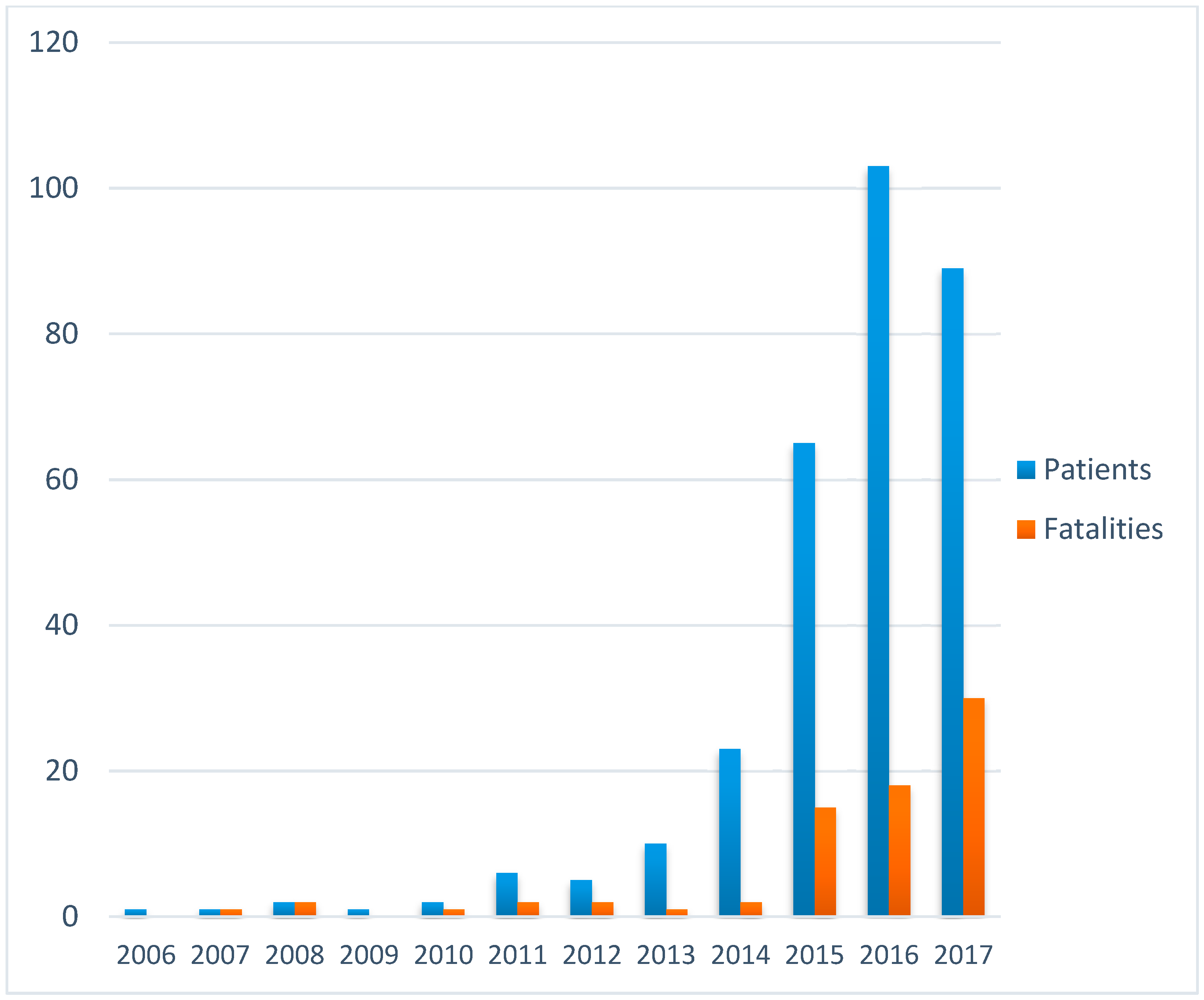
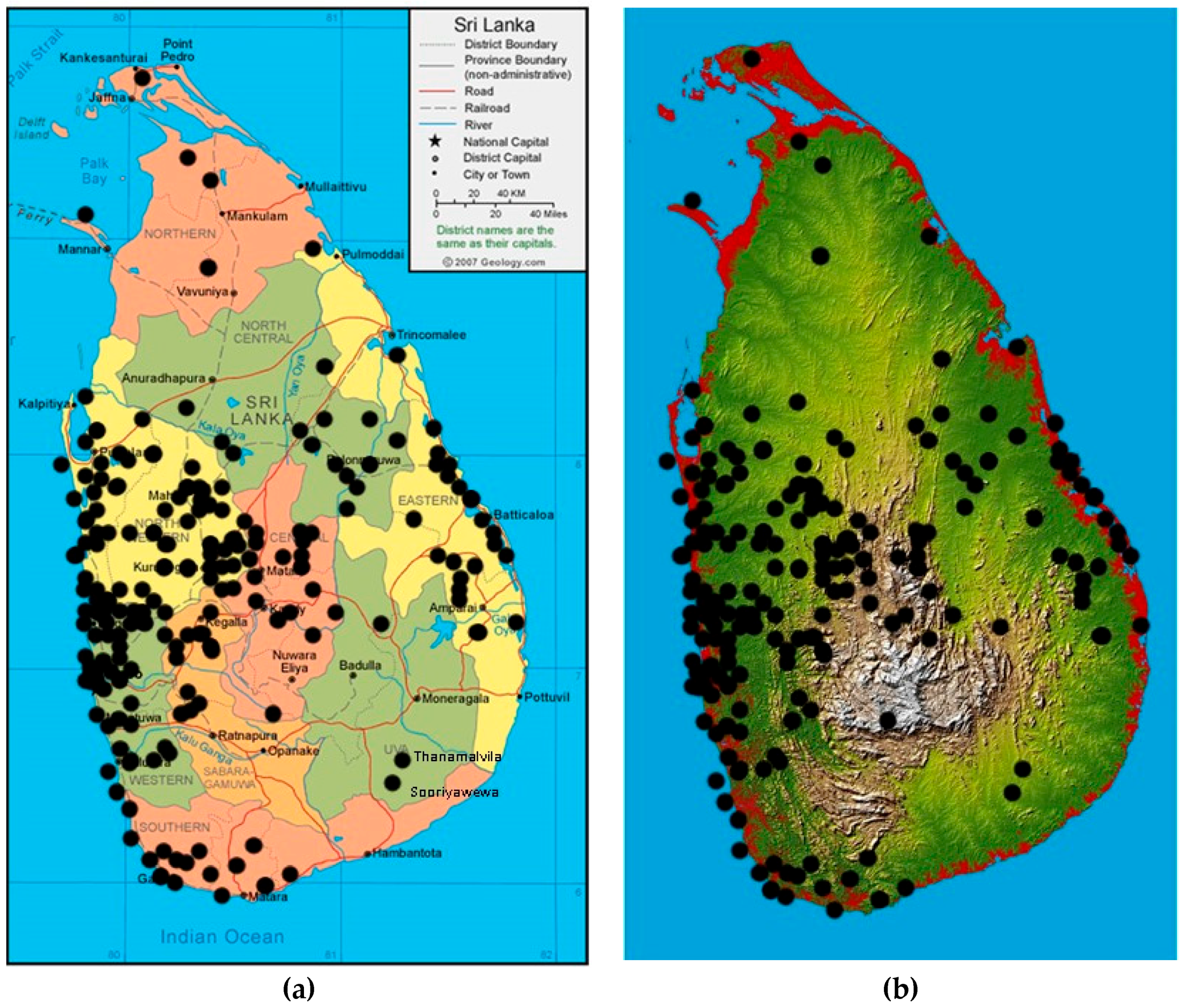
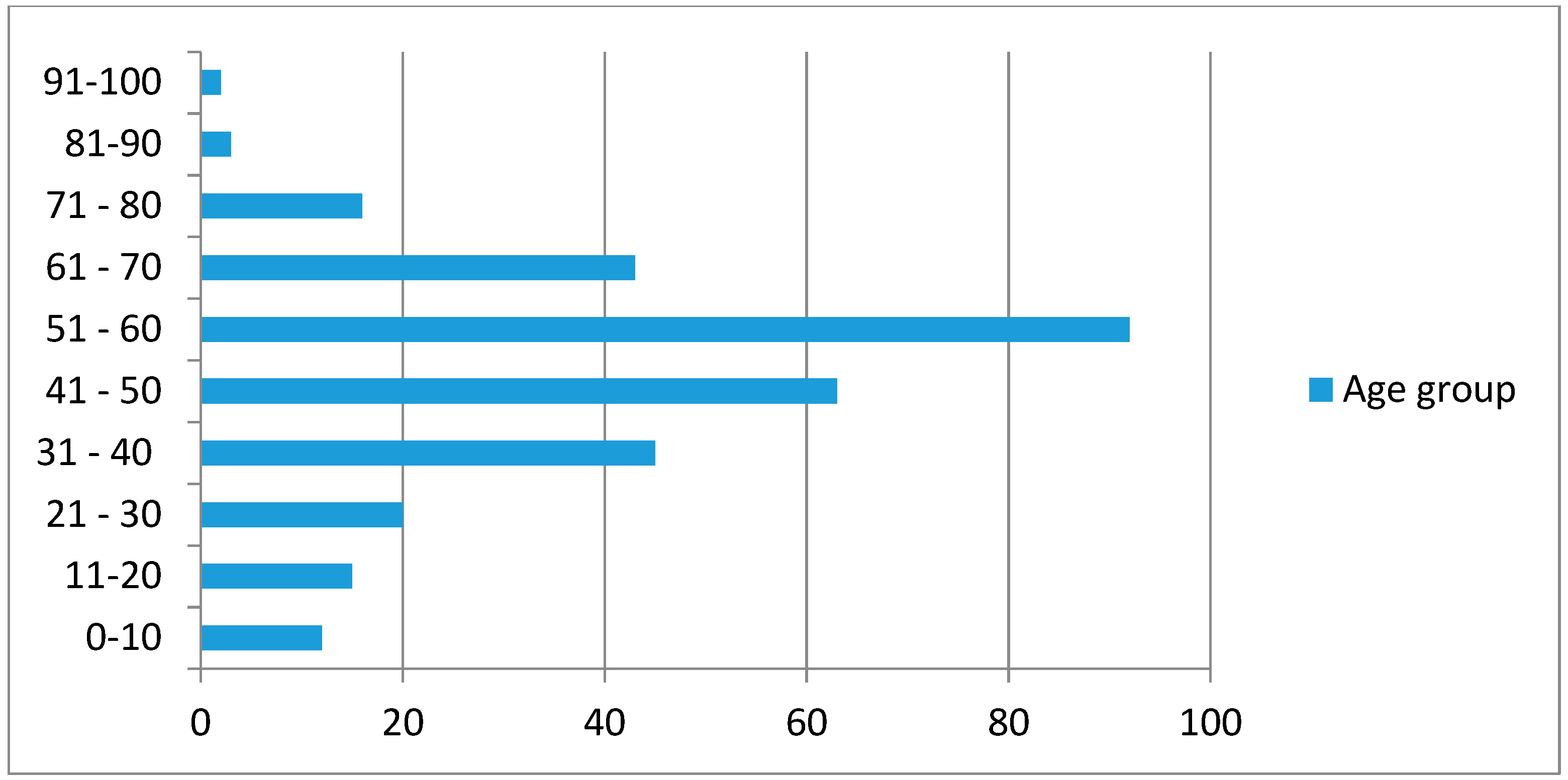
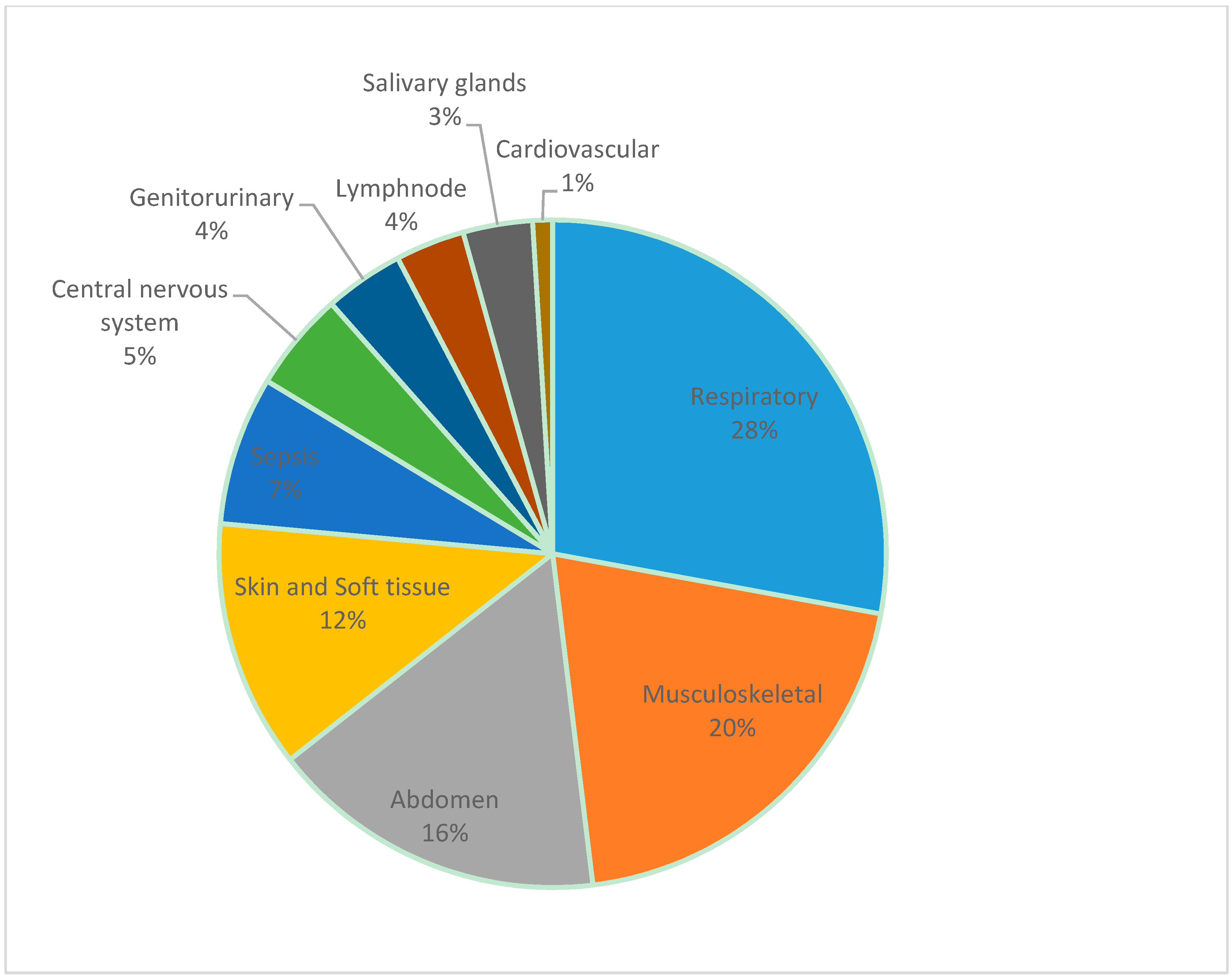
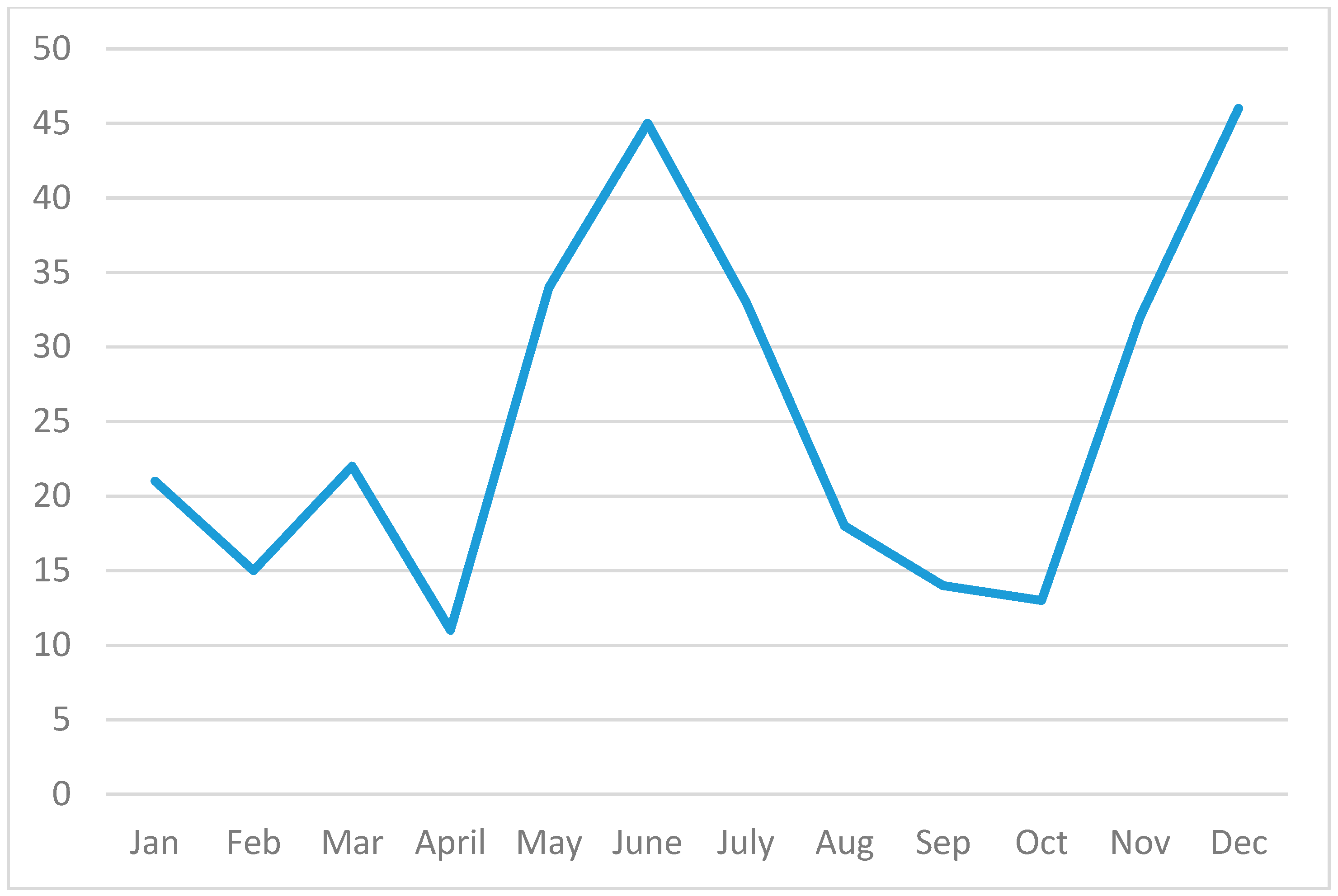
| ST | No | ST | No | ST | No | ST | No | ST | No | ST | No |
|---|---|---|---|---|---|---|---|---|---|---|---|
| 13 | 2 | 590 | 944 | 1139 | 3 | 1147 | 3 | 1435 | 2 | ||
| 132 | 594 | 5 | 1132 | 8 | 1140 | 5 | 1148 | 1436 | |||
| 194 | 598 | 1133 | 1141 | 1152 | 2 | 1437 | |||||
| 202 | 615 | 1134 | 1142 | 2 | 1179 | 1438 | |||||
| 293 | 655 | 1135 | 9 | 1143 | 2 | 1314 | 1439 | ||||
| 308 | 733 | 1136 | 8 | 1144 | 1364 | 1442 | |||||
| 338 | 867 | 1137 | 18 | 1145 | 1413 | ||||||
| 474 | 912 | 2 | 1138 | 1146 | 1434 | 6 |
© 2018 by the authors. Licensee MDPI, Basel, Switzerland. This article is an open access article distributed under the terms and conditions of the Creative Commons Attribution (CC BY) license (http://creativecommons.org/licenses/by/4.0/).
Share and Cite
Corea, E.M.; De Silva, A.D.; Thevanesam, V. Melioidosis in Sri Lanka. Trop. Med. Infect. Dis. 2018, 3, 22. https://doi.org/10.3390/tropicalmed3010022
Corea EM, De Silva AD, Thevanesam V. Melioidosis in Sri Lanka. Tropical Medicine and Infectious Disease. 2018; 3(1):22. https://doi.org/10.3390/tropicalmed3010022
Chicago/Turabian StyleCorea, Enoka M., Aruna Dharshan De Silva, and Vasanthi Thevanesam. 2018. "Melioidosis in Sri Lanka" Tropical Medicine and Infectious Disease 3, no. 1: 22. https://doi.org/10.3390/tropicalmed3010022
APA StyleCorea, E. M., De Silva, A. D., & Thevanesam, V. (2018). Melioidosis in Sri Lanka. Tropical Medicine and Infectious Disease, 3(1), 22. https://doi.org/10.3390/tropicalmed3010022





